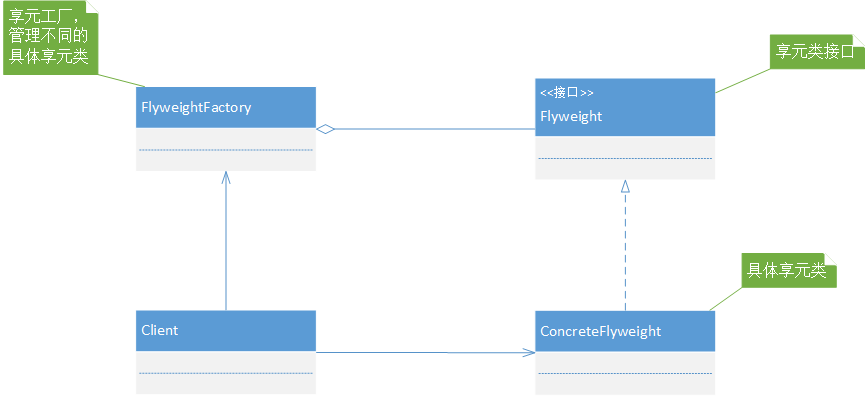享元模式核心掌握的一点就是——共享。如果一个程序代码中存在大量细粒度的对象,而这些大量的对象造成了很大的存储开销时就应该考虑使用。例如一个博客网站,每个人根据自己的账号登录自己的博客,此时每个“博客类”就应该成为共享,这也称为内部状态,但每个人博客里的数据又不同,这时用不同的账号区分也即是称为外部状态。

UML类图如图所示。我们将具体的享元类抽象成一个接口。
1 package day_12_flyweight; 2 3 /** 4 * 享元类接口 5 * @author 余林丰 6 * 7 * 2016年10月12日 8 */ 9 public interface Flyweight { 10 void operation(int extrinsicstate); //这里的extrinsicstate就是上面所说的外部状态 11 }
对享元类接口的具体实现。
1 package day_12_flyweight; 2 3 /** 4 * 具体享元类 5 * @author 余林丰 6 * 7 * 2016年10月12日 8 */ 9 public class ConcreteFlyweight implements Flyweight { 10 11 /* (non-Javadoc) 12 * @see day_12_flyweight.Flyweight#operation(int) 13 */ 14 @Override 15 public void operation(int extrinsicstate) { 16 System.out.println("博客,账号:" + extrinsicstate); 17 } 18 19 }
享元类工厂。
1 package day_12_flyweight; 2 3 import java.util.HashMap; 4 5 /** 6 * 享元类工厂 7 * @author 余林丰 8 * 9 * 2016年10月12日 10 */ 11 public class FlyweightFactory { 12 private HashMap<String, ConcreteFlyweight> flyweights = new HashMap<String, ConcreteFlyweight>(); 13 14 public FlyweightFactory(){ 15 flyweights.put("X", new ConcreteFlyweight()); 16 flyweights.put("Y", new ConcreteFlyweight()); 17 flyweights.put("Z", new ConcreteFlyweight()); 18 } 19 20 public Flyweight getFlyweight(String key){ 21 return ((Flyweight)flyweights.get(key)); 22 } 23 }
1 package day_12_flyweight; 2 3 /** 4 * 客户端测试 5 * @author 余林丰 6 * 7 * 2016年10月12日 8 */ 9 public class Client { 10 public static void main(String[] args){ 11 int extrinsicstate = 100; //代码外部状态 12 FlyweightFactory f = new FlyweightFactory(); 13 Flyweight fx = f.getFlyweight("X"); 14 fx.operation(extrinsicstate); 15 16 Flyweight fy = f.getFlyweight("Y"); 17 fx.operation(--extrinsicstate); 18 } 19 20 }
这样我们就实现了一个最简的享元模式,给出享元模式的定义:运用共享技术有效地支持大量细粒度对象。那什么时候能考虑使用享元模式呢?如果一个应用程序使用了大量的对象,而大量的这些对象造成了很大的存储开销时就应该考虑使用;还有就是对象的大多数状态可以外部状态,如果删除对象的外部状态,那么可以用相对较少的共享对象取代很多组对象,此时可以考虑使用享元模式。——《大话设计模式》